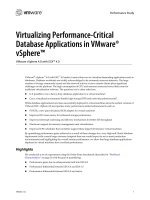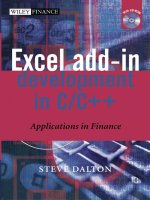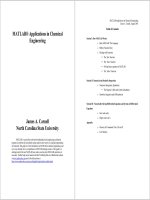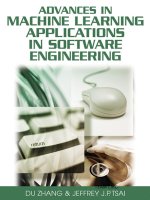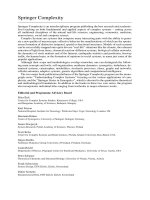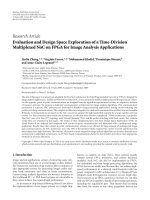leszek wojnar - image analysis applications in materials engineering
Bạn đang xem bản rút gọn của tài liệu. Xem và tải ngay bản đầy đủ của tài liệu tại đây (21.87 MB, 232 trang )
i
mage
analysis
Applications in
Materials Engineering
Leszek Wojnar
CRC Press
Boca Raton London New York Washington, D.C.
© 1999 by CRC Press LLC
CRC Series in
Materials Science and Technology
Series Editor
Brian Ralph
Control of Microstructures and Properties
in Steel Arc Welds
Lars-Erik Svensson
The Extraction and Refining of Metals
Colin Bodsworth
The Quantitative Description of the
Microstructure of Materials
K.J.
Kurzydlowski and Brian Ralph
Grain Growth and Control of Microstructure
and Texture in Polycrystalline Materials
Vladimir Novikov
Corrosion Science and Technology
D. E. J. Talbot and J. D. R. Talbot
Image Analysis: Applications in
Materials Engineering
Leszek
Wojnar
© 1999 by CRC Press LLC
Library of Congress Cataloging-in-Publication Data
Wojnar, Leszek.
Image analysis applications in materials engineering / Leszek
Wojnar.
p.
cm. (Materials science and technology series)
Includes bibliographical references and index.
ISBN 0-8493-8226-2 (alk. paper)
1.
Materials Testing. 2. Image analysis. 3. Image processing-
-
Digital techniques. I. Title. II. Series:
Materials science and
technology (Boca Raton, Fla.)
TA410.W65 1998
621.1'1 dc2l
98-34435
CIP
This book contains information obtained from authentic and highly regarded sources.
Reprinted material is quoted with permission, and sources are indicated. A wide variety of
references are listed. Reasonable efforts have been made to publish reliable data and information,
but the author and the publisher cannot assume responsibility for the validity of all materials or
for the consequences of their use.
Neither this book nor any part may be reproduced or transmitted in any form or by any means,
electronic or mechanical, including photocopying, microfilming, and recording, or by any infor-
mation storage or retrieval system, without prior permission in writing from the publisher.
The consent of CRC Press LLC does not extend to copying for general distribution, for
promotion, for creating new works, or for resale. Specific permission must be obtained in writing
from CRC Press LLC for such copying.
Direct all inquiries to CRC Press LLC, 2000 Corporate Blvd., N.W., Boca Raton, Florida
33431.
Trademark Notice: Product or corporate names may be trademarks or registered trademarks,
and are only used for identification and explanation, without intent to infringe.
© 1999 by CRC Press LLC
No claim to original U.S. Government works
International Standard Book Number 0-8493-8226-2
Library of Congress Card Number 98-34435
Printed in the United States of America 1 2 3 4 5 6 7 8 9 0
Printed on acid-free paper
Preface
Many of my friends complained that all the books on image analysis
were prepared for mathematicians rather than for laboratory workers.
It
was an impulse to issue in 1994, in collaboration with Miroslaw
Majorek, a simple textbook on computer-aided image analysis, obvi-
ously written in Polish. Some of my foreign colleagues looked at this
book, appreciated its graphic form and suggested, that it should be
published in English.
My first reaction was that it was not worthy enough. Surprisingly,
they answered with a very tempting argument: you started to write this
book because you did not find appropriate ones on the market. Maybe
yes So, now you have my English version in your hands and I would
like to point out its three main properties, that can be important for
you, as a reader:
•
it is devoted really to applications. So, you will not find a system-
atic description of image processing operations. Instead, you can
look for a certain problem - for example, grain boundary detection
- and get immediately, possibly a full solution to this problem
•
it is written in a very simple manner and illustrated with numerous
pictures that will help you to understand it. Probably, many items
can be understood after studying only the illustrations. But do not
worry about the text - I avoid equations whether possible
•
all the examples were processed by myself and thoroughly ex-
plained.
You will not find incomplete explanations, cited from
other works. It may happen that my solution is not the optimum
one, but it always works. You will know how to repeat it on your
own equipment and I hope, my book will inspire you to experiment
with your apparatus.
Probably nobody is able to face a challenge such as writing
a technical book without significant help from others. I am not an
exception, either. So, I would like to express my sincere thanks to all
those, who helped me, even if I am unable to cite their names - simply,
the list would be too long. But among these generous persons there are
a few I must list here.
First, I am really indebted to Brian Ralph, who generously agreed
to undertake the burden of improving my English. Second, I would
© 1999 by CRC Press LLC
like to thank Christopher Kurzydlowski, who encouraged me to start
the whole project, for his support. I have to point out that my under-
standing of image analysis would be much, much less without the
support from my French colleagues, Jean Serra and, especially, Jean-
Louis Chermant. I would like to acknowledge also all my friends who
gave me their images which were used to illustrate the algorithms.
And last but not least - many thanks to Bruno Lay and Gervais
Gauthier from ADCIS/AAI, who delivered free of charge, the newest
version of their image analysis software to use for processing all the
examples.
-
Cracow, August 1998
© 1999 by CRC Press LLC
Leszek Wojnar, D.Sc.,
is an Associate
Professor
at Cracow
University of
Technology, Poland. His research inter-
ests are in image analysis, stereology
and materials engineering. He is affili-
ated with the Polish Society for Materi-
als Engineering, the International Soci-
ety for Stereology and the Polish Soci-
ety for Stereology.
His Ph.D. thesis obtained at the In-
stitute
of
Materials Science, Cracow
University of Technology (1985) was
dedicated to the role of nodular graphite
in the fracture process of cast iron.
Dr. Wojnar is known for his innovative methods in teaching oriented
towards problem solving. In recent years (1990-1997) he has worked
on various aspects of the application of computer technology in mate-
rials science, including image analysis and development of the soft-
ware for weldability assessment. Dr. Wojnar has participated as
a member to various advisory boards of the congresses in stereology
(Freiburg, 1989, Irvine, California, 1991, Prague, 1993 and Warsaw,
1997). He was an invited lecturer in Freiburg and Warsaw and worked
as editor for many conference proceedings.
Dr. Wojnar has published more than 50 articles in periodicals and
conference proceedings and has published two books (in Polish):
Computerized Image Analysis
with M. Majorek (1994) and
Applica-
tion
of Computational
Methods in
Weldability
Assesment
with
J.
Mikula (1995). His work
Principles of Quantitative Fractography
(1990) issued at the Cracow University of Technology was the first
such complete monograph in Poland and gave him the D.Sc. position.
An unusual accomplishment and one which stems from the exist-
ing financial climate surrounding Cracow University is that he devel-
oped his own private laboratory on image analysis which now works
in conjunction with universities throughout Poland. Recent works of
this small laboratory are devoted mainly to applications in medicine.
The Author
© 1999 by CRC Press LLC
Acknowledgments
I
would like to express my sincere thanks to all my friends and
colleagues who nicely allowed me to use their images as illustration
material in this book. These generous helpers were (in alphabetical
order):
•
Jacek Chrapon
'
ski (Figures 4.11, 4.12a and 4.13a)
•
Aleksandra Czyrska-Filemonowicz (Figures 4.29, 4.31a, 5.6 and
5.7)
•
Wieslaw Dziadur (Figures 2.3 and 4.23a, b)
•
Marek Faryna (Figures 4.4a and 4.23d)
•
Gervais Gauthier (Figure 4.16a)
•
Jan Glownia (Figure 4.27)
•
Gabriela Górny (Figures 2.18a, 2.28a and 4.28a)
•
Krzysztof Huebner (Figures 2.32, 3.1, 3.2, 3.3, 3.4, 3.5 and 3.6)
•
Anna Kadluczka (Figure 4.3a)
•
Jan Kazior (Figures 2.10, 2.11 a and 7.2)
•
Krzysztof Kurzydlowski (Figure 4.24)
•
Anita Myalska-Olszówka (Figure 5.9 )
•
Carl Redon (Figure 4.40a)
•
Kazimierz Satora (Figures 4.23e, 5.14a and 5.15a)
•
Janusz Szala (Figures 3.7, 3.8, 3.9, 4.17a and 4.18b)
•
Adam Tabor (Figures 2.9, 3.10 and 4.26)
•
Roman Wielgosz (Figures 2.13a, 2.15a and 4.30a).
Thank you.
© 1999 by CRC Press LLC
Contents
Chapter one -
Introduction
1.1
Digital images and their analysis versus the human vision
system
1.2
General concept of the book
Chapter two - Main tools for image treatment
2.1
About this chapter
2.2
Basic image enhancement
2.3
Filters
2.4
Binarization
2.5
Mathematical morphology
2.6
Fourier transformation
2.7
Edge detection
2.8
Combining two images
2.9
Mouse etching
Chapter three - Image acquisition and its quality
3.1
Specimen preparation
3.2
Image acquisition
3.3
Shade correction
3.4
Removing artifacts
3.5
Basic tips
Chapter four - Detection of basic features
4.1
Grain boundaries
Example 1: Grains in a model alloy used for machine
-
ability tests
Example 2: Restoration of grain boundaries in the QE 22
alloy after high-temperature homogenization
Example 3: Grains in a polystyrene foam
Example 4: Grains of a clean, single-phase material
Example 5: Grains in a CeO
2
ceramic
Example 6: WC-Co cermet
Example 7: Grains in a high-speed steel
Example 8: A tricky solution to a nearly hopeless case
© 1999 by CRC Press LLC
4.2
Other features detected like grains
4.3
Pores and isolated particles
4.4
Chains and colonies
4.5
Fibers
Chapter five - Treatment of complex structures
5.1
Textured and oriented structures
5.2
Very fine structures
5.3
Fracture surfaces
Chapter six - Analysis and interpretation
6.1
I
mage processing and image analysis
6.2
Measurements of single particles
6.3
First measurements - numbers
6.4
Shape
6.5 Grain size
6.6
Gray-scale measurements
6.7
Other measurements
Chapter seven - Applications and case histories
7.1
Quality and routine control
7.2
Simulation
7.3
Research and case histories
7.4
Concluding remarks
References
© 1999 by CRC Press LLC
Chapter one
Introduction
1.1
Digital images and their analysis versus the
human vision system
During the last ten years we observed a tremendous expansion of
more and more powerful personal computers and development of
user-friendly, graphically oriented operating systems. The computing
power of commercial machines doubles in approximately one to two
years, and even more powerful computers are used on a laboratory
scale. Obviously, the most advanced computer is worth nothing with-
out appropriate software. The unprecedented market success of gen-
eral purpose software developers forced numerous smaller companies
to look for niche applications, very often connected with computer
graphics. The availability of frame grabbers, together with the wide
range of video cameras, allows the computer to see images and in-
duces the temptation to try simulation of the human vision system. As
a consequence, a good deal of image analysis software is currently at
hand. It allows many research workers to practice with tools previ-
ously available only for a limited group of specialists.
However, new tools also provide new problems, often caused by
some misunderstanding. High resolution graphics allows one to pro-
duce photo-realistic effects, leading to impressive virtual reality prod-
ucts. One can walk through non-existent buildings, observe crash tests
of newly designed but still non-existent cars, train surgeons on virtual
patients, etc. Similar effects can be obtained on small scale in almost
all personal computers and the appropriate software is commercially
marketed.
Computerized graphical presentations, often demonstrated in real-
time mode, are extremely impressive, especially for novices. They are
used very frequently, particularly for advertising purposes. Unfortu-
nately, such breathtaking spectacles in virtual reality may lead to
a false impression that computers can do almost everything. Moreo-
ver,
many people are disappointed and frustrated when trying to do
anything on their own. Such a case is very common in image analysis
applications, which work perfectly, but only on the test images. Let us
try to find the reason for this situation.
© 1999 by CRC Press LLC
Fig. 1.1. The noisy image (up) contains some information which is totally
invisible for human eyes but can be easily developed after proper application
of very simple transformations (down). See text for more details.
© 1999 by CRC Press LLC
Let us analyze the upper image in Fig. 1.1. It looks as uniformly
noisy, perhaps with some brighter areas in the middle and lower right-
hand corner. However, it is enough to apply two simple steps:
•
minimum filter that converts any point in the image into its darkest
neighbor (see Section 2.3 for more details)
•
simple linear LUT transformation (see Section 2.2 for more de-
tails) in order to get optimum brightness and contrast.
After such a treatment we get the lower image shown in Fig. 1.1.
Thanks to the simplicity of the transformations applied the whole
process is very fast and impressive. We can add that for nearly every
image it is possible to find an appropriate procedure that can extract
features necessary for further analysis. The only problem is that usu-
ally we do not know
HOW TO DO IT?
In demonstration files this problem is already solved. Detailed analy-
sis of the demo can give us some guidelines for our own cases, but it
is never universal knowledge. So, the next and possibly the most im-
portant problem is
HOW MUCH TIME WILL WE SPEND TO FIND THE PROPER
SOLUTION?
It depends on our experience, type of image to be analyzed, etc. How-
ever, in general, to find the acceptable solution takes much more time
than we expect.
It seems a paradox that we have an extremely powerful image
analysis program working very fast during demonstration but we can
hardly do anything on our own. Simultaneously, we do not have simi-
lar difficulties with other packages devoted to word processing, data
analysis, charting, etc. After a little deeper analysis of the above ob-
servations we can put forward the following conclusions, decisive for
our further successes or failures in image analysis:
•
computers perform very fast
predefined
sequences of operations
but are almost useless for development of new, original sequences
which are key for any development in image analysis
•
we cannot directly use our own experience for development of
computerized algorithms for image analysis because we have no
detailed knowledge of the functionality of our brain. Moreover,
computers are not simplified brains and work in their own, entirely
different way
© 1999 by CRC Press LLC
•
our visual system is a very efficient tool - we can read nearly un-
readable text, we can recognize a person seen only as a distant,
walking silhouette or find a proper way from a very simplified
plan. But it takes years of training to do it quickly and well. So, no
wonder that it is impossible to get, in every case, an immediate,
satisfactory solution using computerized image analysis
•
stiff, emotionless logic of computers is not good for subtle recog-
nition tasks requiring wide knowledge and intuition
•
on the other hand human visual system is sensitive to illusion and,
surprisingly, very conservative in its method of analysis. For ex-
ample, it is very difficult to read a mirrored text
•
computers are faster in simple, repeatable operations and therefore
offer an ideal platform for measurements.
It is evident from the above analysis that there are diverse, evident
and important differences between the human visual system and the
properties of computerized image analysis systems. The development
of efficient algorithms has to take a lot of time, therefore image analy-
sis should be applied mainly in the case of repeatable tasks, like qual-
ity control or scientific research. Recent, computerized technological
progress requires numbers - any quantity should be described as 10,
50 or 150 instead of bad, good or excellent. Image analysis systems
seem to be an ideal aid for such data treatment.
The variety of material structures being analyzed in industrial and
scientific laboratories means that nearly every user of image analysis
equipment has to develop from time to time his own, unique proce-
dure. There is only very limited opportunity to use specialists in com-
puter science or interdisciplinary teams for this purpose. Finding the
proper solution requires an extremely deep understanding of the proc-
esses under analysis and years of experience cannot be summarized
within minutes or even hours. Similarly, explanation and understand-
ing of isolated filters used in image analysis, available in numerous
textbooks, is insufficient for construction of effective algorithms. The
aim of this book is to fill the gap between the theory of image analysis
and the practice of material microstructure inspection.
© 1999 by CRC Press LLC
1.2
General concept of the book
The goal, described generally in the previous section, is very difficult
to obtain. This difficulty lies in the fact that we need to join two en-
tirely different intellectual spheres: a very strict and highly abstract
theory of numerical transformations and often unpredictable, highly
practical knowledge of material characteristics.
It seems that the proper solution can be found using some simple
rules, briefly described below. First, we will use the terminology
common for materials science. Thus we will use
microstructure, grain
or
particle
instead of
scene, set, figure
or
object.
Second, we will
avoid mathematical formalism whenever possible. For practical rea-
sons it is less important if the transformation is idempotent, isotropic,
homotopic or additive. On the other hand, it is of highest priority to
know if the given filter can properly distinguish precipitates of various
phases. Third, we will concentrate on typical problems and the sim-
plest solutions, as it seems to be better to tell everything about some-
thing than to tell something about everything.
In order to adapt to the needs of various groups of potential read-
ers, the contents of this work are divided into smaller, possibly inde-
pendent parts. As a consequence, the book is organized into seven
chapters, including this one. Their contents are roughly presented
below:
•
Chapter one
is devoted to general
introduction
and you are reading
it now
•
Chapter two
describes the
main tools for image treatment
and can
be recognized as the essence of the transformations most fre-
quently used in image analysis. In other words, this chapter gives
the bricks necessary to build an image analysis process. It contains
comprehensive descriptions of the nomenclature and basic proper-
ties of the transformations as well as some guidelines about where
the given family of operations can be successfully applied
•
Chapter three
deals with the problem of
image acquisition and its
quality.
Nearly all the transformations, even the simplest ones, of
the image are connected to some data loss. Therefore the quality of
initial images is of the highest importance. This chapter gives basic
rules for specimen preparation, image acquisition and removal of
the most frequently met distortions
•
Chapter four
is devoted to
detection of basic features in the mate-
rials
microstructure like grains, fibers, pores, etc. These features
are essential for understanding of the material microstructure.
© 1999 by CRC Press LLC
However, they often are quite difficult to extract from the initial
image
•
Chapter five
covers
treatment of complex structures,
being much
more difficult to detect than the basic features described in the pre-
vious chapter. Fine and textures structures are analyzed here. The
algorithms discussed in this chapter are usually very complex and
require understanding of the items analyzed in Chapters two and
four
•
Chapter six
gives
analysis and interpretation
of pre-treated im-
ages. This chapter describes the technique of digital measurements
and their application in microstructural characterization. It dis-
cusses properties and specific errors met in digital measurements.
Chapter six is somewhat related, discussing basic rules of stereol-
ogy
•
Chapter seven summarizes the knowledge in previous chapters. Thus
it is devoted toapplications and case histories
analysis. The ex-
amples discussed in this chapter are selected to show how to solve
image analysis tasks, which should be of great value for the nov-
ices. Simultaneously, it allows experienced users to confront their
own practice with the other viewpoints.
Obviously, the algorithms presented in this book are not exclusive.
One can easily find other ways leading to identical or very similar
results - this is a very common situation in image analysis. It may also
happen that some methods supplied here can be significantly acceler-
ated or simplified. Moreover, the book covers only a small portion of
possible tasks and obviously a limited subset of existing procedures is
used. These limitations are introduced consciously, in order to keep
the volume of the whole work relatively small and to avoid very nar-
row applications. Once more, the goal of the whole work is twofold:
•
to give
effective
solutions to the most common problems met in the
analysis of images in materials science
•
to
show the way
to reach this effective solution in order to teach
the reader to solve his own, unique problems by him- or herself.
© 1999 by CRC Press LLC
Main tools for image treatment
2.1
About this chapter
This book is designed primarily for materials science professionals
interested in the application of image analysis tools in their research
work. It is assumed that they:
•
have a thorough knowledge of materials science as well as wanting
to apply image analysis tools quickly and efficiently in their work
•
have little experience (if any) with computer-aided image analysis
and have no time for in-depth studies of computer algorithms.
There is a subtle dilemma about how to present the image analysis
tools for this audience. There is a temptation to offer a general but
reader-friendly treatment of computer tools but it would be just an-
other general purpose book on image analysis, of which one can find
hundreds on book shelves. Another solution could be to skip all intro-
ductory information on image analysis and focus only on specialized
algorithms suitable for materials science. However, this also seems to
be the wrong approach; such a work would probably be understand-
able only by a narrow group of specialists, knowing all the tips prior
to reading this book. To make things more complex, the text should
not refer to any existing software. Thus, the lack of standardized no-
menclature should be also taken into account.
The solution chosen here is to give a general description of all the
main groups of transformations, without any reference to detailed
analysis of the algorithms, formal restrictions, etc. This information is
divided into two independent but complementary parts for all the
groups analyzed:
•
verbal description, giving the general properties of the transforma-
tion analyzed as well as the possible application directions
•
graphical illustration, showing the sample image before and after
the transformation.
Verbal description
covers a general idea of the transformation
analyzed, together with its potential application area. Furthermore, to
enable it to work more easily with a great variety of software, the most
commonly used synonyms are cited. It is very significant that no for-
mal definition of the procedure body or parameters, nor analysis of the
Chapter two
© 1999 by CRC Press LLC
algorithms available, are submitted. The aim of this introductory part
is to provide the very basic knowledge necessary for individual work
with image analysis packages. The reader should learn what is possi-
ble from a given family of transformations. He should also possess at
least some rough knowledge concerning possible application areas.
Afterwards, detailed data on image analysis algorithms can be found
in specialized literature or software documentation.
Graphical illustration
covers both initial and post-processing im-
ages, thus enabling one to get the feeling of what
direction
i
n image
alteration can be expected for a given family of transformations. To
allow one to compare various transformation families, the same sam-
ple image is used whether possible. Additionally, the line profile (plot
of pixel values along a line) at exactly the same location is added to
all the images. This allows a more quantitative way of exploring the
changes in image data.
2.2
Basic image enhancement
Any image discussed here is a mosaic of very small areas, called pix-
els, filled with a single gray level or digitally defined color. Thou-
sands of pixels, touching each other and placed within a (usually
square) grid, give us the illusion of a realistic, smooth picture. This
pixel nature of computerized images allows us to store them and trans-
form them as matrices of numbers. This is the very basis of computer-
aided image analysis.
Gray images are usually described by 256 gray levels. This corre-
sponds to 8 bits per pixel as 256 = 2
8
.
In this representation 0 equals
black and 255 denotes white. 256 gray levels are quite sufficient for
most applications as humans can distinguish approximately only 30 to
40 gray levels. In some applications, however, other depths of image
data are used: 2 (binary images), 12, 16 or 32 bits per pixel.
Color images are most commonly stored as RGB (Red Green
Blue) images. In fact, each of the RGB channels is a single gray im-
age.
Analysis of color images can be interpreted as the individual
analysis of the gray components put together at the end to produce the
final color image. Thus, understanding the principles of gray image
analysis gives sufficient background for color image treatment.
Due to the digital nature of the computer images described above
they can be modified using usual mathematical functions. The sim-
plest functions can be applied for basic image enhancement, usually
known as brightness and contrast control. Some selected functions of
© 1999 by CRC Press LLC
this type are schematically shown in Fig. 2.1. Illustrative examples, as
described in Section 2.1, are shown in Figs. 2.2 and 2.3.
In the case of 8 bit images, any transforming function has only
256 values corresponding to 256 argument values. So, instead of de-
fining the function and calculating its value for each pixel, it is much
simpler and quicker to define a table of 256 values, which can be very
quickly substituted in the computer memory. This method of compu-
tation is extremely useful in computers. The tables of pixel values are
usually called
LUT (Look-Up Table). Thus, instead of defining the
transform function we quite often define the LUT.
Brightness and contrast control in image analysis are fully analo-
gous to the brightness and contrast adjustments in any TV set. In-
creased contrast can cause the loss of some data. Part of the dark gray
levels can be converted into black and part of the bright pixels can be
converted into white (see Figs. 2.1 and 2.2b). These negative effects
can be avoided or significantly reduced after using a suitable combi-
nation of both transformations; for example, brightness with lower
contrast.
Brightness and contrast are useful for visualization purposes but
in general, due to the possible loss of data, are rarely applied in image
analysis. There is, however, one exception usually called
normaliza-
tion.
This is a kind of brightness/contrast modification leading to the
image with the lowest pixel values equal to 0 (or black) and the high-
est pixel values equal to 255 (or white). Usually, if one analyzes
a series of images they vary in contrast and brightness. This effect can
be caused by numerous factors, like apparatus aging, voltage varia-
tion, dust, etc. Normalization allows us to alter these images as if they
were recorded in very similar or identical brightness and contrast con-
ditions.
Therefore, normalization is quite often applied as the first
transformation in image analysis.
In a similar way, one can also produce the
negative
or
inversion
of
the image. It is one of the simplest LUT transformations. White be-
comes black and vice versa. If we add the initial image and its nega-
tive, we will get an ideally white surface. The negative can be used for
some special purposes, described later in this book.
Due to its non-linear characteristics, the human eye is more sensi-
tive to changes in the brighter part of the gray level spectrum than in
the darker one. This can be easily noted in Fig. 2.1, where one can
analyze two rectangles with blend fills from black to white. Try to
choose the region filled in 50% with black. Most probably you will
choose a point which is closer to the black side of the rectangle,
whereas 50% black is exactly in the middle. As a consequence of this
© 1999 by CRC Press LLC
non-linearity we can notice many more details in the brighter region
of the image than in its darker part.
Fig. 2.1.
Selected functions for basic image enhancement.
So, to get an image with details easily seen in the whole image,
one should stretch the dark and squeeze the bright range of gray lev-
els.
This can be done with the help of
gamma modulation
(see Fig.
2.1). An example of this transformation is shown in Fig. 2.2. Note that
at first glance the result of gamma modulation seen in Fig. 2.2c is very
similar to the image produced by increased brightness (Fig. 2.2b).
Closer analysis shows the difference in the brightest areas. A bright
particle in the lower right corner is entirely white after increased
brightness whereas after gamma modulation all the details are still
visible, as in the initial image.
© 1999 by CRC Press LLC
a) initial image
b) initial image with higher brightness
c) initial image after gamma modulation
Fig. 2.2.
Brightness and contrast control.
© 1999 by CRC Press LLC
Another example of gamma modulation, applied to a fracture sur-
face, is shown in Fig. 2.3. It should be pointed out, however, that all
the details visible after gamma modulation obviously exist in the ini-
tial image. This transformation only makes them visible to the human
eye.
Fig. 2.3.
Gamma modulation (right image) allows observation of details in
the darker part of the fracture surface (left image).
Another interesting non-linear LUT transformation is known as
histogram equalization.
This has the following properties:
• it
preserves the natural sequence of grays, similarly to gamma
modulation. In other words, features darker in the initial image re-
main darker in the transformed image
•
if we divide the whole gray scale into small classes of equal size,
the same number of pixels will be observed in each class and the
histogram of gray levels will be flat (equalized).
Histogram equalization can produce images with somewhat unnatural
appearance (see Fig. 2.4b), but simultaneously it produces an image
with the highest possible contrast, preserving approximately all the
details of the initial image. As will be shown later, histogram equali-
zation is useful for advanced and automatic thresholding (binari-
zation).
There exist many other LUT modifications and they are applied
for artistic or visualization purposes. They have much less meaning
for extracting features from images, as their results are often unpre-
dictable.
© 1999 by CRC Press LLC
a) initial image
b) initial image with equalized histogram
c) initial image after gamma modulation
Fig. 2.4. Effects of histogram equalization and gamma modulation.
© 1999 by CRC Press LLC
2.3
Filters
Filtering is one of the most common processes in nature and technol-
ogy. One meets filters in everyday life: sand and earth filter polluted
water and make it clean, paper filters produce tasty coffee or tea, vac-
uum cleaners filter dust particles out of the air, electronic filters
smooth radio signals which lead to perfect sound or video images, etc.
Filters of various types are also among the most frequently used tools
for image treatment.
7,
13, 21, 7
0, 80, 84, 85, 87
The principle of filtering is sche-
matically and intuitively shown in Fig. 2.5.
Fig. 2.5. Filtering process (schematically).
The transformations described in Section 2.2 can be called
point-
type operations.
This means that the result of any transformation of
any image pixel depends only on the initial gray value of this pixel
and is independent of its neighbors. For example, the negative of any
white point is always black, whatever the gray levels are of the sur-
rounding pixels. By contrast, filters are
neighbor-type operations.
In
other words, the pixel value after filtering is a function of its own
value and the gray levels of its neighbors. Usually, filters return values
that are weighted means of neighboring pixels. The majority of soft-
ware packages offer numerous predefined filters as well as user-
defined ones. In this last case the user can define the matrix of coeffi-
cients used to compute the weighted mean returned by a filter.
© 1999 by CRC Press LLC
a) initial image
b) initial image after smoothing filtering
c) initial image after median filtering
Fig. 2.6. Simple filters for noise reduction - smoothing and median.
© 1999 by CRC Press LLC
Digital images are often polluted with noise produced, for exam-
ple, by video cameras in the case of insufficient illumination or by
SEM detectors. Obviously, noise should be removed from such im-
ages prior to any quantitative analysis. This can be done using suitable
filters.
In Fig. 2.6 one can analyze the effect of two simple filters suitable
for noise reduction. This effect is rather subtle, so it is more visible in
the profile plots than in the images. The first,
smoothing filter
(Fig.
2.6b), is probably the simplest possible filter - it returns just an arith-
metic mean of the pixels in a 5x5 size square. Matrices of sizes 3x3
and 7x7 are also very common. In more advanced packages, larger
matrices are available as well. They can be called
a box
filter,
an
av-
eraging filter,
etc.
The smoothing filter provides an image with re-
duced noise and a somewhat out-of-focus appearance. To reduce this
last phenomenon, other filters, for example,
Gaussian,
are introduced.
In these filters, diverse points have different weights in the computed
average; generally the weight is smaller for pixels more distant from
the central (just altered by a filter) pixel.
Smoothing filters work well if the image is not excessively noisy.
In other cases they produce unsuitable results. Let us analyze it with
an example. Assume we use a 3x3 kernel and the pixels have the fol-
lowing values put in ascending order:
6, 8, 12, 15, 15, 17, 19, 20, 95.
It is evident that the pixel values are in the range from 6 to 20 and the
pixel
with value of 95 should be thrown away. If we compute the
arithmetic
mean value, as a smoothing filter does, we will get the
value of 23. Simultaneously, the arithmetic mean from the first eight
values is equal to 14. This last value is both intuitively acceptable and
far from 23. So, in this case a smoothing filter does not work well.
Better results can be obtained if we use
a
median filter
(see Fig.
2.6c). The median is the value situated exactly in the middle of the
series of numbers set in ascending order. In the example analyzed
above, it would be the fifth value, i.e., 15. So, a median filter can be
effectively applied for treating heavily noisy images and in most cases
is the best solution available. Moreover, this filter has two important
properties: it does not add new values to the image data (median is
one of the already existing values) and it keeps the image sharp.
Noise, especially of a periodic character, can also be efficiently
removed with the help of Fourier transformations. This transformation
is,
however, much more difficult to perform. There are some restric-
tions to the images and only advanced packages offer efficient tools
for Fourier analysis. It will be described in Section 2.6.
© 1999 by CRC Press LLC

